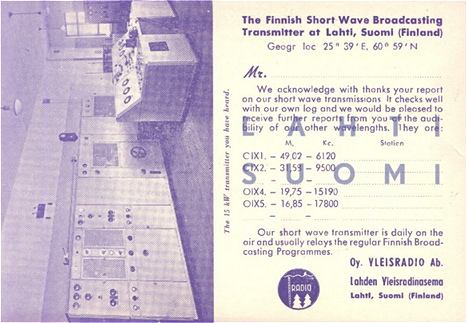

Lahti Radio & TV Museum is located in the old building of Lahti Long Wave broadcasting station. The station used to relay Finnish National and External Services programmes till it was closed down in 1993. Since the start in 1928 most years Lahti was the title holder as the most powerful radio station in Nordic Countries. However, if the true importance of grounding effect had been known back in 1928, the station had never been located in Lahti - on the dry ridge, where over 15 huge copper plates had to be dug down to provide at least a modest grounding for high power transmitter purposes. It is not a coincidence, that today the most high power broadcasters are located by seashore. The altitude and central location in Southern Finland that once seemed to be the advantage of Lahti, are less important than a location near salt water or open waterway.
Lahti was so famous for its LW station, that few people know that Lahti was actually the initial location of Finnish External Service broadcasting. 1 kW SW transmitters were installed in Lahti in 1938, and already the test programmes resulted reception reports from far away. The most faraway listeners of Lahti SW station were from Australia and New Zealand. The Foreign Service began in 1st January 1939 when the very first English language broadcast to North America was transmitted. It was a legendary broadcast because of world famous composer Mr Jean Sibelius. There happens to be only one recording of Sibelius playing or conducting his music, and it was recorded in this first English language broadcast to North America. According to reception reports, this broadcast was even heard well in the target area. For Helsinki Olympic Games of 1940, four high-power SW transmitters were ordered from Marconi in Great Britain. Unfortunately the war came between, and the transmitters never arrived. When Radio Finland decided to expand after the World War II, a brand new location was chosen for SW transmissions; Pori, in Western Finland, by the Baltic Sea. The archives of Lahti Radio Museum have a plenty of reception reports from the Vintage Radio Era. In that time, numerous competing radio clubs and devoted enthusiasts wrote interesting, colourful reception reports on wonderfully designed, handsome report forms designed by the radio clubs, and, in some cases, by the individual listeners. Reception reports shown on
this page are scans from photocopies, so the original colours can't be seen,
unfortunately. Nevertheless, we hope this makes interesting reading from the years when
the Radio was the King. |

|